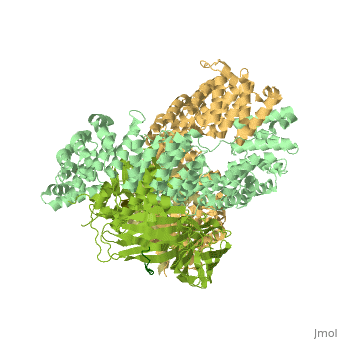4p6z
From Proteopedia
Crystal structure of the human BST2 cytoplasmic domain and the HIV-1 Vpu cytoplasmic domain bound to the clathrin adaptor protein complex 1 (AP1) core
Structural highlights
FunctionVPU_HV1S1 Enhances virion budding, by targeting human CD4 and Tetherin/BST2 to proteasome degradation. Degradation of CD4 prevents any unwanted premature interactions between viral Env and its receptor human CD4 in the endoplasmic reticulum. Degradation of antiretroviral protein Tetherin/BST2 is important for virion budding, as BST2 tethers new viral particles to the host cell membrane. Mechanistically, Vpu bridges either CD4 or BST2 to BTRC, a substrate recognition subunit of the Skp1/Cullin/F-box protein E3 ubiquitin ligase, induces their ubiquitination and subsequent proteasomal degradation. The alteration of the E3 ligase specificity by Vpu seems to interfere with the degradation of host IKBKB, leading to NF-kappa-B down-regulation and subsequent apoptosis. Ion channel activity has also been suggested, however, formation of cation-selective channel has been reconstituted ex-vivo in lipid bilayers. It is thus unsure that this activity plays a role in vivo (By similarity). Publication Abstract from PubMedBST2/tetherin, an antiviral restriction factor, inhibits the release of enveloped viruses from the cell surface. Human immunodeficiency virus-1 (HIV-1) antagonizes BST2 through viral protein u (Vpu), which downregulates BST2 from the cell surface. We report the crystal structure of a protein complex containing Vpu and BST2 cytoplasmic domains and the core of the clathrin adaptor protein complex 1 (AP1). This, together with our biochemical and functional validations, reveals how Vpu hijacks the AP1-dependent membrane trafficking pathways to mistraffick BST2. Vpu mimics a canonical acidic dileucine-sorting motif to bind AP1 in the cytosol, while simultaneously interacting with BST2 in the membrane. These interactions enable Vpu to build on an intrinsic interaction between BST2 and AP1, presumably causing the observed retention of BST2 in juxtanuclear endosomes and stimulating its degradation in lysosomes. The ability of Vpu to hijack AP-dependent trafficking pathways suggests a potential common theme for Vpu-mediated downregulation of host proteins.DOI: http://dx.doi.org/10.7554/eLife.02362.001. Structural basis of HIV-1 Vpu-mediated BST2 antagonism via hijacking of the clathrin adaptor protein complex 1.,Jia X, Weber E, Tokarev A, Lewinski M, Rizk M, Suarez M, Guatelli J, Xiong Y Elife. 2014 Apr 29;3:e02362. doi: 10.7554/eLife.02362. PMID:24843023[1] From MEDLINE®/PubMed®, a database of the U.S. National Library of Medicine. See AlsoReferences
| ||||||||||||||||||

